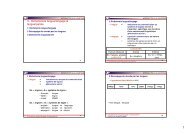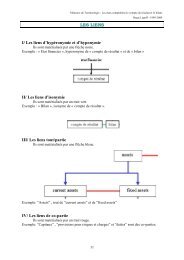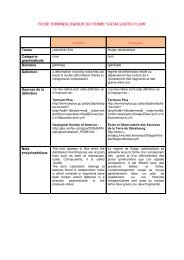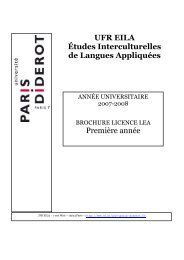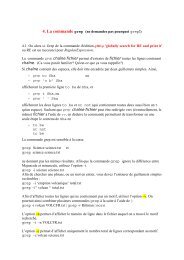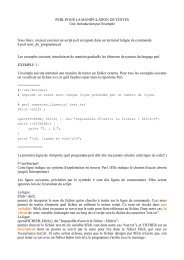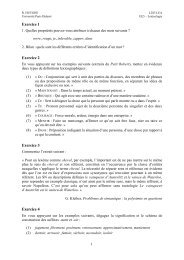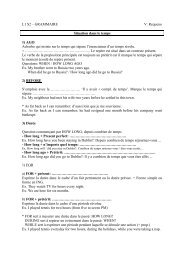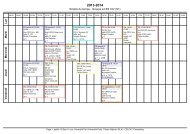INTRODUCTION TO ENGLISH TEXT LINGUISTICS
INTRODUCTION TO ENGLISH TEXT LINGUISTICS
INTRODUCTION TO ENGLISH TEXT LINGUISTICS
You also want an ePaper? Increase the reach of your titles
YUMPU automatically turns print PDFs into web optimized ePapers that Google loves.
Professor Christopher Gledhill<br />
(Notes de cours, Linguistique du texte anglais, 48LGAN23, EILA, Université Paris Diderot)<br />
‘Collocation is a process by which words combine into larger chunks of expression. Some<br />
collocations involve words which seldom occur in other combinations (for example: ‘auburn<br />
hair’, ‘rancid butter’, ‘ups and downs’). Others are turns of phrase made up of words that<br />
commonly occur in many combinations (‘of course’, ‘so be it’, ‘as a matter of fact’). These<br />
expressions are all related in phraseology, roughly defined here as ‘the preferred way of<br />
saying things in a particular discourse’ (a formula adapted from Kennedy 1984).’<br />
The question of what a ‘collocation’ is rather important because, as you will find out next year, my<br />
colleagues and I happen to be specialists in this particular area of phraseology. Unfortunately, the<br />
actual definition of collocation is rather tricky and depends very much on how you see language.<br />
Consider the very different perspectives on this issue in the following two quotes:<br />
“A very basic fact of language is that speakers are constantly confronted with expressions<br />
that they have never encountered in their previous linguistic experience, and that they can<br />
nevertheless produce and understand with no effort.” (Noam Chomsky, 2002, quoted in A.<br />
Belletti & L. Rizzi (eds) On nature and language, Cambridge: Cambridge University Press, p2.)<br />
[learning a language is] “... learning to say what the other fellow expects us to say under the<br />
given circumstances… Once someone speaks to you, you are in a relatively determined<br />
context and you are not free to say what you please.” (J. R. Firth 1935/1957 Papers in<br />
Linguistics, 1934-1951. London: Oxford University Press, p28.)<br />
What we mean by ‘collocation’ therefore can vary; for the American linguist Chomsky the<br />
preferred way of saying something in the language is basically very variable indeed (‘collocation’ is<br />
a question of syntax). For the British linguist, Firth the preferred way of saying something is<br />
determined to a large extent by our habits and by context (‘collocation’ is a question of context).<br />
Anyway, whatever perspective we wish to take, it is important to note that Firth referred to<br />
‘idiomatic’ or ‘conventional’ patterns of language in terms of ‘Collocation’. Here is how he originally<br />
put it:<br />
‘[a] word is characterised by the company it keeps… collocations of a given word are<br />
statements of the habitual or customary places of the word (J. R. Firth 1935/1957 Papers in<br />
Linguistics, London: Oxford University Press, p181)<br />
A final point on collocation is that there are different types. Generally speaking, it is possible to<br />
distinguish between paradigmatic collocation (which involves a co-selection of words within a<br />
particular context, including pairs such as doctor + hospital, nuclear + atom, etc. - in other words,<br />
the cohesive chains of lexical items we saw in section 2) and syntagmatic collocation (which<br />
involves a co-selection of words within a particular structure, group or clause, as in ask a question,<br />
to curry favour etc.). The notion of ‘paradigmatic collocation’ originates in Halliday & Hasan’s<br />
study Cohesion in English (mentioned in the previous section), in which they claim that<br />
‘collocation’ has an important role to play in building chains of referential links within a text.<br />
Examples of paradigmatic (or ‘text-level’) cohesion can be seen in such examples as climate +<br />
environment, recycle + paper cup, volcano + erupt, etc. Within the category of ‘syntagmatic<br />
24 / 37




